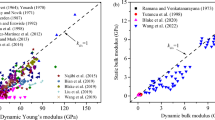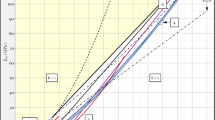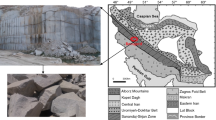Abstract
In the present investigation, dynamic methods for the determination of moduli of elasticity were compared with direct static methods. The dynamic moduli of rocks, such as Young's modulus (E) and Poisson's ratio (v) were determined, using both mechanical resonance frequency and classic P and S wave ultrasonic velocity techniques. For this purpose rock samples from different areas of France, covering a wide range of velocity values, were used. The mechanical resonance frequencies were investigated using a Grindo-Sonic machine while the P and S wave ultrasonic velocities were measured using a Pundit ultrasonic machine, connected to an oscilloscope. The static moduli were determined using deformation gauges. Statistical interpretation of the test results indicated significant correlation between these dynamic and static methods. Accordingly, the above non-destructive dynamic methods are suitable for the determination of static moduli of elasticity.
Resume
Dans la présente étude, les méthodes de détermination du module d'élasticité dynamique sont comparées aux méthodes de calcul statique direct. Les modules d'élasticité dynamique des roches tels que le module de Young (E) et le coefficient de Poisson sont déterminés en utilisant à la fois une méthode de résonance en fréquence et la méthode classique de mesure de la vitesse des ondes P et S. Pour cette recherche, différentes roches de France, couvrant un large éventail de vitesses des ondes, ont été choisies, la méthode de résonance en fréquence a été établie en utilisant un appareil Grindo-Sonic, tandis que pour la mesure des ondes P et S, nous avons utilisé un Pundit et les lectures ont été effectuées sur un oscilloscope. Le module d'élasticité statique a été déterminé en utilisant des jauges de contrainte. L'interprétation statistique des essais fournit une bonne corrélation entre les méthodes dynamiques et statiques utilisées. En accord avec nos recherches, le module d'élasticité statique peut être déterminé avec une bonne approximation en utilisant des méthodes dynamiques non destructives.
Similar content being viewed by others
References
Johnson, R. B. and De Graff, J. V., ‘Principles of Engineering Geology’ (John Wiley, New York, 1988), p. 497.
Clark, G. B., ‘Deformation moduli of rocks’,ASTM STP402 (1966) pp. 133–174.
Irfan, T. W. and Deerman, W. R., ‘Engineering classification and index properties of a weathered granite’,Bull. IAEG 17 (1978), 79–80.
Auger, F., ‘Influence des fluides interstitiels sur la vitesse du son dans les matériaux de construction. Mesures expérimentales et conséquences sur les diagnostics d'altérabilité’,International Measurement and Testing in Civil Engineering, Lyon (1988), pp. 259–268.
Christaras, B., ‘Méthode d'évaluation de l'altération et modification des propriétés mécaniques des granites en Grèce de Nord’,Bull. IAEG 43 (1991) 21–26.
Mosse, E., ‘Relations entre vitesse du son, module d'élasticité et coefficient de Poisson, mesurés par des méthodes statiques et dynamiques: application aux matériaux pierreux’ (DEA, Univ. of Poitiers, La Rochelle, 1990) p. 100.
Spinner, S. and Tefft, W. E., ‘A method for determining mechanical frequencies and for calculating elastic moduli from these frequencies’,Proc. Am. Soc. Test. Mater. 61 (1961), 1229–1238.
Glandus, J. T., ‘Rupture fragile et resistance aux chocs thermiques de céramiques à usages mécaniques’, Th. doc., University of Limoges (1981).
King, M. S., ‘Static and dynamic elastic properties of igneous and metamorphic rocks from the Canadian shield’,Int. J. Rock Mech. Min. Sci. Geomech. Abstr. 20 (1983), 237–241.
Eissa, E. A. and Kasi, A., ‘Technical note—Relation between static and dynamic Young's moduli of rocks’,Int. J. Rock Mech. Min. Sci. Geomech. Abstr 25 (1966) 479–482.
Moropoulou, A. and Theoulakis, P., ‘Conditions causing destructive NaCl crystallization into the porous sandstone building material of the medieval city of Rhodes’,Proceedings of the 2nd International Symposium on Conservation of Monuments in the Mediterranean Basin, Geneva (1991) pp. 493–499.
Author information
Authors and Affiliations
Rights and permissions
About this article
Cite this article
Christaras, B., Auger, F. & Mosse, E. Determination of the moduli of elasticity of rocks. Comparison of the ultrasonic velocity and mechanical resonance frequency methods with direct static methods. Materials and Structures 27, 222–228 (1994). https://doi.org/10.1007/BF02473036
Issue Date:
DOI: https://doi.org/10.1007/BF02473036




